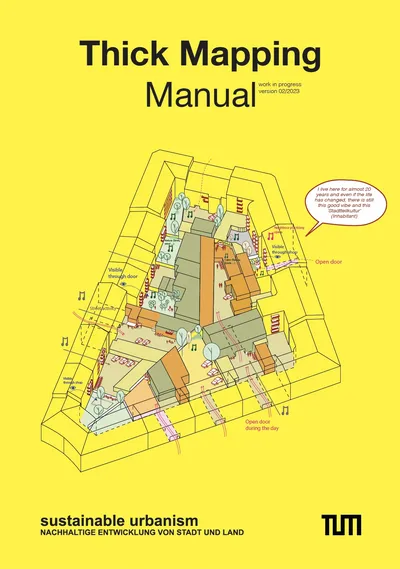Thick Mapping Manual
Work-in-progress field guide to thick mapping
Maps contribute significantly to the work of architects and urbanists. In this handbook, we present a range of mapping tools and methods for collecting data in the urban realm, either from outside the discipline or from the margins of architectural and urban representation. The manual is linked to the 'Thick Mapping' seminar, in which students challenged established mapping conventions by exploring perspectives that emphasise process, everyday practices, conflict and time, and that are not blind to the wider frameworks that influence architecture and the built environment.
The tools and methods in this handbook are intended to complement our toolboxes of architectural and urban analysis, based on the understanding that we must constantly refine and deepen our understanding of the shifting relationships between environmental, social and economic aspects if we are to make our urban environments more sustainable.
Norbert Kling and Tasos Roidis, August 2021
The main literature and references used in the current project include:
Clarke, Adele (2005) Situational Analysis. Grounded Theory After after the Postmodern Turn, Thousand Oaks CA
Clarke, Adele; Friese, Carrie and Washburn, Rachel (2018) Situational Analysis. Grounded Theory After the Interpretive Turn, Thousand Oaks CA, 2nd edition of Clarke (2005)
Corner, James (1999) The Agency of Mapping. Speculation, Critique and Invention, in: Cosgrove, Denis ed. (1999) Mappings, London, pp. 213-252
Geertz, Clifford (1973): Thick Description. Toward an Interpretive Theory of Culture, in: The Interpretation of Cultures. Selected Essays, New York, pp. 3–30
Jungfer, Carsten and Palmieri, Fernanda (2019) Relational States of Dalston. Research Project. University of East London, School of Architecture Computing and Engineering [html] https://repository.uel.ac.uk/item/892wy
Kling, Norbert (2020) Redundant City. A Multi-Site Enquiry Into Urban Narratives of Conflict and Change, Bielefeld [html] https://www.transcript-publishing.com/978-3-8376-5114-0/the-redundant-city/?number=978-3-8376-5114-0
Kling, Norbert and Jungfer, Carsten (2018) Contested Porosities. A Spatial Enquiry into Urban Conflicts in Dalston, East London, in: Wolfrum, Sophie. Stengel, Heiner. Kurbasik, Florian. Kling, Norbert. Dona, Sofia. Mumm, Imke. Zöhrer, Christian eds. (2018) Porous City. From Metaphor to Urban Agenda, Basel, pp.260–265. https://doi.org/10.1515/9783035615784-055
Kling, Norbert and Kurbasik, Florian (2018) Hanging Around in the Urban Field, in: Wolfrum, Sophie. Stengel, Heiner. Kurbasik, Florian. Kling, Norbert. Dona, Sofia. Mumm, Imke. Zöhrer, Christian eds. (2018) Porous City. From Metaphor to Urban Agenda, Basel, pp.238–240. https://doi.org/10.1515/9783035615784-051
kollektiv orangotango+ ed. (2018) A Global Collection of Counter-Cartographies, Bielefeld [html] www.transcript-verlag.de/978-3-8376-4519-4/this-is-not-an-atlas/, 2nd ed.
Senatsverwaltung für Stadtentwicklung Berlin ed. (2007) Urban Pioneers, Berlin, co-edited by Overmeyer, Klaus / studio UC
Yaneva, Albena: Mapping Controversies as a Teaching Philosophy in Architecture, in: Stratis, Socrates ed. (2016) Guide to Common Urban Imaginaries in Contested Spaces. The ‘Hands-on Famagusta’ Project, Berlin, pp.147–161, 2016
Zoller, Doris: Schnittstelle Erdgeschoss. Wechselwirkungen zwischen Öffentlich und Privat, Monsenstein und Vannerdat, 2016
